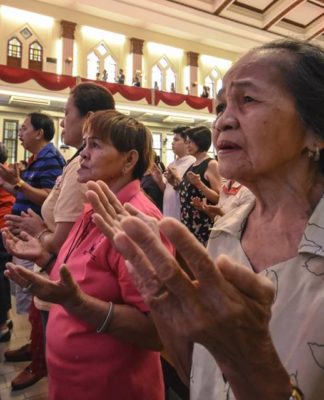 THERE IS more to the month of May than Laboracay, the summer party destination during the one-day holiday.
THERE IS more to the month of May than Laboracay, the summer party destination during the one-day holiday.
Since Proclamation No. 439 was signed in 2003, the National Commission for Culture and the Arts (NCCA) has been holding the celebration of the National Heritage Month every May to honor the country’s cultural treasures and raise awareness of their significance.
The NCCA deems the University as a heritage conservation paragon. With its high-quality research outputs, UST has been of great help in protecting cultural heritage sites and artifacts.
NCCA Commissioner Fr. Harold Rentoria, OSA, who heads the NCCA Subcommission on Cultural Heritage (NCCA-SCH), said UST has also helped both national and local governments in cultural mapping, conservation of archival materials and restoration of important works of art.
Last May 4, UST and the NCCA signed a memorandum of understanding that basically formalized their partnership in promoting and protecting tangible and intangible cultural heritage in the Philippines.
It is not a lopsided partnership; since it also complements UST’s efforts in enhancing its cultural heritage prestige.
That prestige owes to the growing reputation of UST as a repository and advocate of cultural heritage, as reflected in several of its well-known agencies such as the UST Archives, Vivencio del Rosario Heritage Library, Center for the Conservation of Cultural Properties and the Environment in the Tropics, UST Museum of Arts and Sciences, and Cultural Heritage Studies Program of the UST Graduate School.
UST also has esteemed faculty members who are also heritage scholars and experts, as well as artists and cultural workers, some of them holding important positions in government or international institutions, such as Dean Raul Sunico of the Conservatory of Music (he’s president of the Cultural Center of the Philippines) and CCPET head Eric Zerrudo, who’s vice-president of the Philippine Unesco Commission.
Father Rentoria himself, who’s an Augustinian friar, has UST links since he’s an alumnus of the UST Ecclesiastical Faculties.
I believe UST-NCCA accord is promising for a 404-year-old university which abounds in cultural treasures and still has potentials waiting to be tapped.
The NCCA can help stabilize the protection of UST’s five cultural treasures–the UST Main Building, Central Seminary, the Arch of the Centuries, UST’s open spaces, and the most recent UST Archive’s collection of the ancient baybayin scriptures.
(Much, much earlier, in 1939 in fact, the National Historical Institute placed a historical marker at the old UST Press, today’s UST Publishing House, as being the oldest press in the Philippines.)
Through the memorandum, the NCCA will also stage more cultural events on campus which will equally render more exposure for UST. There will be a higher chance that the University will finally be recognized globally for its outstanding efforts.
Likewise, this step forward can harvest more UST graduates who can become cultural heritage practitioners and advocates themselves.
The University already has an impressive pool of alumni who are inclined toward the arts–a myriad of award-winning artists to testify the entitlement.
With the likes of UST Archivist Jose, who once headed the NCCA SCH, and well-acclaimed sculptor Ramon Orlina among many other artists, it is undeniable that the University has produced outstanding culture and heritage figures.
Just recently, the Cultural Center of the Philippines (CCP) named College of Fine Arts and Design alumnus Alvin Zafra as one of its Thirteen Artists Awardees for 2015.
Zafra joins the array of Thomasians who have been previously awarded with the same prestigious merit.
Chris Millado, CCP’s vice president and artistic director, said in a press conference that Zafra and his co-awardees are distinguished for their strong impact in the visual arts movement.
Through this partnership, UST can further gauge its students into becoming high-caliber artists or cultural preservation workers. More Thomasians can bring the same sense of pride for UST.
I see no disadvantage in the accord. I hope the NCCA’s projects and activities will be executed effectively and truly raise awareness of the people on the importance of heritage. With this optimism is also the faith that this may also be the start for a beautiful and lasting partnership between UST and the NCCA.
















